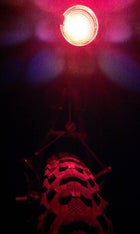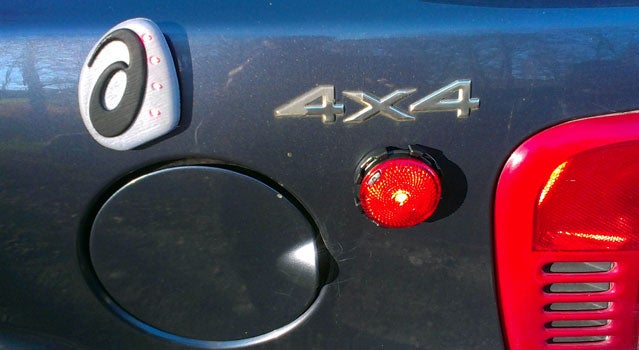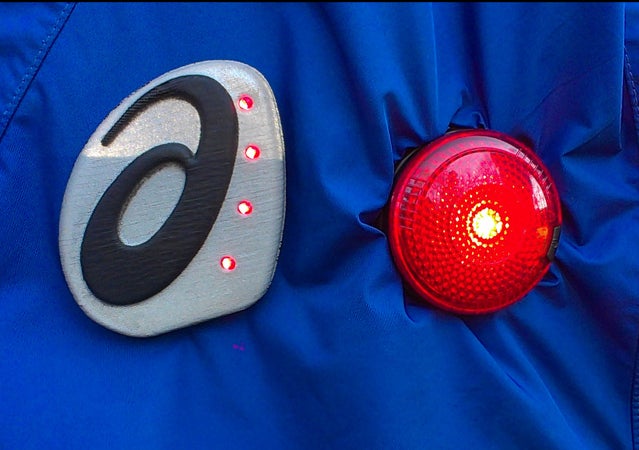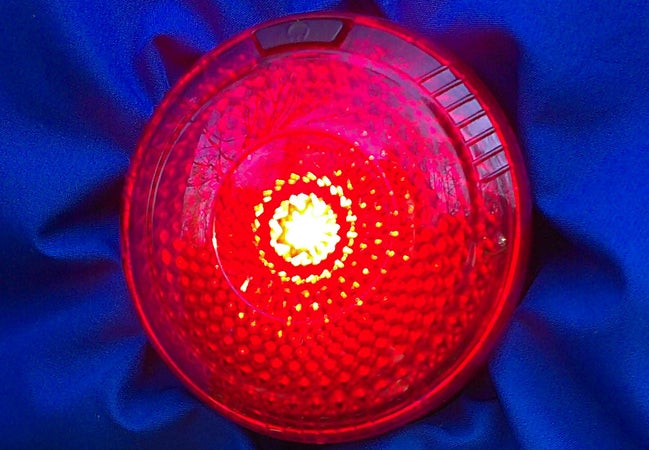We review products all the time, and are often left wondering why some work so well—or don’t. When a new LED running light called the came in, we decide to call up the inventor and find out how this clever little beacon came about.
 The Snapalite LED safety light.
The Snapalite LED safety light.Where most lights clip to the edge of your jacket or hat, or swing from your wrist, the Snapalite uses a powerful clamp to attach to your clothing. It clings securely to fabric anywhere for maximum visibility. The light also has magnets to stick to a vehicle and a silicone strap for cycle use. When it arrives in stores in early December, it will cost between $10 and $15.
The inventor, Scott Hardy, 44, has been making outdoor stuff from a young age. He started his outdoor goods career at 24 by creating an all-weather “overshoe.” It’s a waterproof cover for your boots that provides another layer of protection in extreme weather, and it’s used in the Iditarod and on Alaskan glacier tours. When L.L. Bean picked up Hardy’s overshoe, he was off to the races as a professional inventor, and has since developed a running shoe, snowboarder’s backpack, grocery bag that functions as a bike pannier, and a nifty gadget to ease plantar fasciitis.
After the jump, we ask Hardy how he invented the light. If you’ve ever had fond thoughts of becoming an inventor, here’s a chance to see how the sausage gets made. Then we’ll give the Snapalite a road test along with the other top option for staying visible on dark streets.
Snapalite: How It’s Made

As a product developer with , Scott Hardy spends his days thinking up new gear, as well as helping other inventors go to market. We called him to find out how to get the dream job of full-time gear inventor.
People always ask inventors the same dumb question: How do you get all your ideas? But, really, how do you get your ideas?
They are always out of a need that comes up in your own life. Most night running lights suck, and I was tired of having them fall off or fail. I run three or four times a week, around three to five miles. But it’s dangerous to be out on the roads without a light. There are more distracted drivers than ever.
With almost any other light on the market, you have to clip it on, wear it as a headband, or hook it to a waistband, which then your shirt or jacket covers. The idea was to sandwich your jacket material in a plastic clamp, so you could place it anywhere.
First we printed a working prototype by (the high-end 3-D printing technology that uses strong plastics). We tested at Reach the Beach, the relay in New Hampshire that goes all night, so people need a safety device. We got a lot of feedback. People talked about the placement of the button and the ease of putting it on and taking it off.
You were 25 when you started your first company, . Can anyone still invent a killer product and start a company?
Right now, the number of startup bike companies is unbelievable. If you connect the dots of with with new , you can really just come up with something and manufacture it wherever pretty easily.
The question is scale. Can you get to a point where your garage business is paying you a salary that’s equal to what you would get working for someone else? For a lot of people that might be 50 or 100 grand a year, and just to enjoy doing your thing in your garage. But can you scale your business up to make that?
It’s possible. The opportunity to create a subcult brand is better now than ever. A large segment of the outdoor goods market is looking for niche things, not made by the millions in China. They are willing to pay a premium. It’s locavore culture meets consumer products.
But you didn’t do that with Snapalite. Your light is made in China.
We had a bigger market in mind, and at first we approached U.S. manufacturers. The U.S. has been hammered by the departure of so much manufacturing that it’s surprisingly hard to find a factory interested in taking on a new project. The domestic factories are either really busy because they have a lot of opportunities, or they are not set up to work with independent developers. Two of our products have been made in the U.S., but for the Snapalite, we went abroad.
If someone wants to be an inventor of outdoor gear, what areas should they focus on?
I tend to work on things that solve problems right in front of me. I run, bike, hike, and ski near my home in Vermont. Other inventors see opportunities elsewhere. Right now there’s a wave of new mothers generating baby product ideas—especially mothers in the workforce who are higher level marketing people. All of a sudden they’re home with the kids and solving design problems.
We have a few long-range product development projects, but I enjoy small, simple projects like the running light where people use it right away. It becomes a direct dialog with people. Runners will start trying my light in a few weeks. I’m sure there will be some good feedback and some bad. I can’t wait!
Snapalite: The Competition

Asics works its logo into a cleverly designed night safety light with four red LEDs. The $15 uses powerful neodymium magnets to secure to any garment. So, like the Snapalite, you can put it anywhere on your clothing for high visibility and ease of use. Both the Snapalite and Asics weigh about half an ounce.
But do the magnets hold on tight? We placed an ordinary running shell between the magnets and the backing, and unless you shook very hard (harder than would occur in normal running), it stayed on. But while putting on a thick fleece jacket and straightening it, the Asics would fall to the ground.
Points for the Asics: A reflective surface when the light is off; better looking; magnets are probably gentler than plastic clips for sensitive fabrics.
Points for the Snapalite: Brighter LED; stronger attachment to thick garments; on/off switch can be operated while still attached to a jacket; can be lashed to a bike with included strap.


